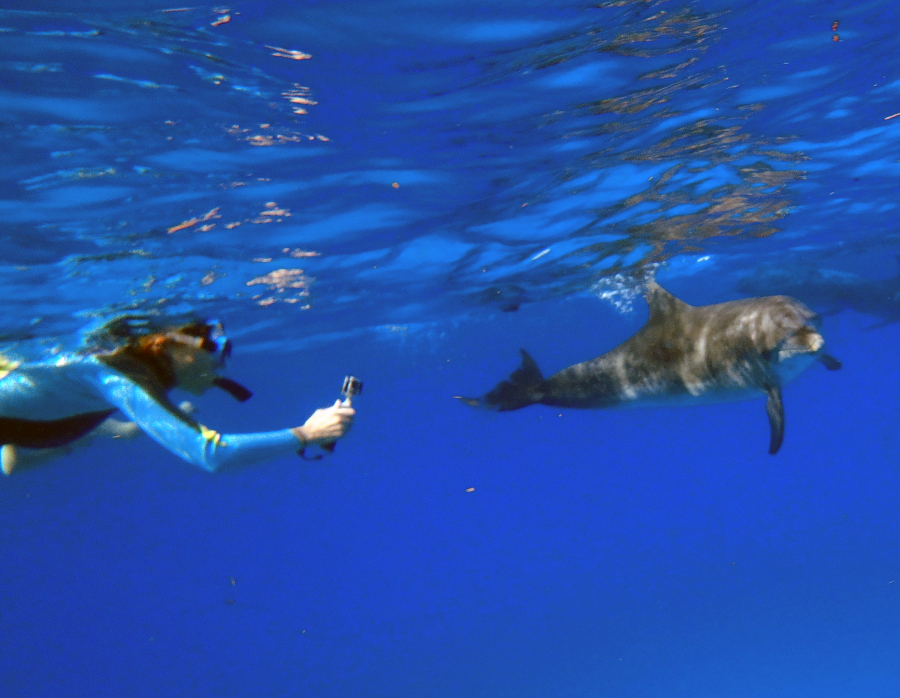Some Suggested Manners for Dolphin-Watching and Dolphin-Swimming Participants

Over the past 15 years human interest in dolphins and whales has increased at what seems to be an exponential rate. This trend shows no sign of declining. With our heightened interest has come a desire to observe and interact with dolphins and whales in their natural environment. A positive effect of this is a renewed sense to protect the environment.
It is important to realize that the ocean is not our home, but our playground. It is, however, home to dolphins, whales, and numerous other marine organisms. We are guests and should act accordingly. The list below presents some guidelines and suggestions that we encourage anyone planning to interact with dolphins or whales to follow – whether you are watching at the surface or swimming with dolphins underwater. The guidelines are provided for your safety as well as for the safety of the dolphins and whales. Even though equipped with a huge smile and a seemingly forever-harmonious disposition, dolphins and whales are wild animals. Always remember this fact.
DO NOT TOUCH the dolphins. If the dolphins want physical contact with people, they will initiate it. If you try to touch one dolphin, then all the dolphins invariably leave the area. Not only does this adversely affect dolphin behavior but it irritates the other people with your group since everyone loses on the swim.
DO NOT CHASE or swim after, or follow the dolphins away from the group of humans. They are incredibly graceful and powerful swimmers. There is no way any human could keep up with them. Swimming after them when they move off simply forces them to move a bit further away.
DO NOT FEED the dolphins. Dolphins are capable of finding their own food and it is important for them to continue to do so. Learning about handouts from humans can create bad habits for the dolphins that are very dangerous for them
ALWAYS LISTEN to your Dolphin Guide or Captain. Not only do they have many hours (and often years) experience around the dolphins, they also have much experience on the water. Most of them are interested to answer questions and share their knowledge.
The ocean is an amazing entity! Your trip may have started out just to see dolphins, but you can actually gain much more and learn about the ocean, currents, wind and other animals in the area, like Streaked Shearwaters and flying fish.
Remember your limits! Don’t push yourself – enjoy your trip. If you are not confident about your skin diving abilities, or don’t feel like going in the water, DON’T DO IT. You can have a lot of fun watching from the boat.
LOOK DOWN when actually in the water. The dolphins will often swim right underneath you or from behind you.
Be willing to snorkel below the surface but be careful and aware of your own limitations. If you feel uncomfortable in the water, ask your Dolphin Guide for suggestions. Snorkeling is a fun sport, but only when one is comfortable.
When surfacing to breathe, look up to avoid any potential objects in your way.
BE AWARE of the boat when you are in the water. Be ready to enter the water and be ready to exit when told to do so. When entering, go feet first, holding your mask against your face with your snorkel in your mouth. Generally, look up and forward to see the boat. With waves, it can be difficult to see the boat from underwater.
Dolphin swimming and watching is fun, but tiring. Try to be in good condition to skin dive. The more experience you have in the water, the better time you will have.
If you are an experienced skin diver, you may want to try one or more of the following tips:
The best approaches underwater to swimming dolphins seem to be from an angle that is from the side or at about 45° (roughly). Direct or head-to-head approaches or fast swims at 90° to others usually signify aggressive activity.
Try dolphin kicking (like butterfly swimming with both legs together). It is fast but requires a lot of energy.
Underwater turns, circle swimming and flips may indicate play to dolphins. They may try to imitate you doing these behaviors.
Use your body as a tool to communicate. Remember the streamlined shape of the dolphins.
REMEMBER, the dolphins seem interested in us and therefore come to swim around us. We are visitors to their world and should not abuse the welcome they extend to us. So, let’s reciprocate by not infringing on their activity and by not polluting the oceans. With these simple guidelines, we can show our respect for the ocean and the creatures that live in it.
